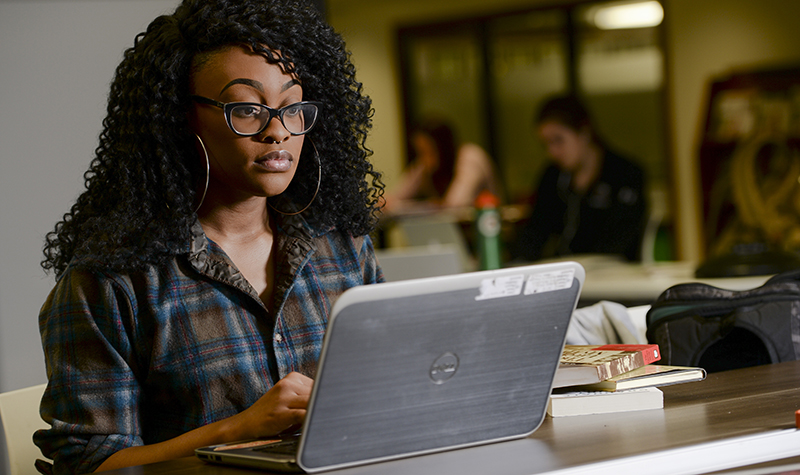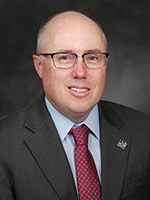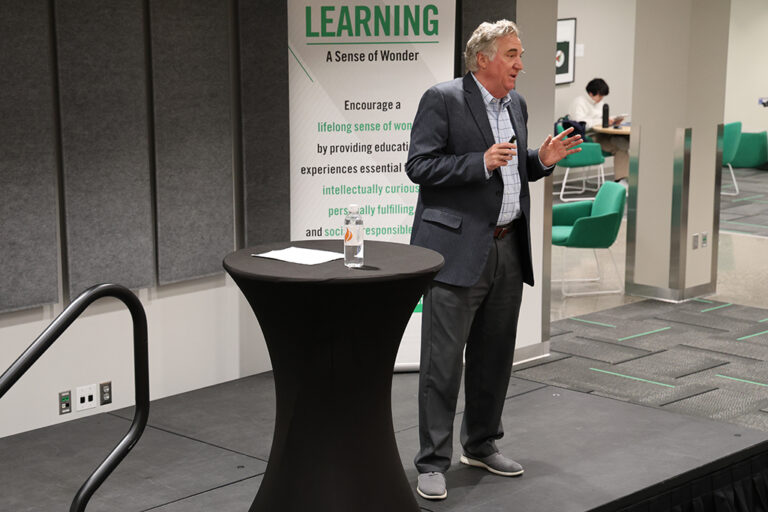In a time of coronavirus, teaching doesn’t stop; it goes remote
Find out how UND supports faculty, and learn some useful tips on teaching remotely

Taping physical workouts online and sharing them with students. Video-streaming a chemistry experiment and sending students the resultant data to analyze. Playing a musical instrument alone in front of a camera for students to listen to later.
These are some of the creative methods that University of North Dakota faculty members are adopting to continue teaching remotely in a time of global coronavirus outbreak.
“I’ve been impressed – but not surprised – at the responsiveness, ingenuity, and thoughtfulness of our faculty,” said Debbie Storrs, UND’s senior vice provost. “They understand the need to be flexible and creative in their teaching, particularly given this unique situation we are all facing.”

On March 12, UND leadership made the decision to shift all forms of teaching to remote instruction for two weeks after the ongoing spring recess. This is a measure that universities increasingly have been embracing to combat the spread of COVID-19, the disease caused by the coronavirus.
While the move heeds guidelines from the Centers for Disease Control and local authorities that promote the safety and health of students, faculty and staff, going remote comes with many logistical considerations for instructors.
“The UND faculty has a lot of experience offering courses and programs using a variety of delivery methods including on-campus and off-campus, face-to-face, online, and self-paced, enroll anytime,” said Jeff Holm, vice provost for online education and strategic planning. “But there are always instructors who haven’t had the opportunity to teach a specific course using a specific delivery method such as remote teaching.”
To onboard every faculty member to the reality of teaching remotely, the professionals at the Teaching Transformation and Development Academy (TTaDA) have been particularly busy this month.
“We are responding to phone calls and email as they are coming in,” said Lynette Krenelka, executive

director of TTaDA. “That is in addition to providing a high level of training and support for faculty and staff.”
Having established a separate web page with resources for remote teaching, TTaDA staff are also assisting faculty upload essential course materials to Blackboard and familiarize themselves with videoconference tools such as Zoom and YuJa.
“We’ve been trying to be as proactive as possible,” said Dara Faul, associate director of academic technologies at TTaDA. Faul, along with the academic technologies staff, Elizabeth Becker, instructional design coordinator, and all of the instructional designers, is managing the Academy’s switch to remote learning.
College deans and chairs have also been referring professors to TTaDA. And, they have also worked internally to smoothen the shift. The College of Engineering and Mines (CEM), for instance, held several meetings with faculty and staff to address their concerns and support their needs.

“I think we’ve got a pretty good handle on things for the next couple of weeks,” said Brian Tande, interim dean of CEM.
College of Arts & Sciences Dean Bradley Rundquist echoed that assertion. The College sent out a survey to faculty, which identified “gaps” in preparedness early on, said Rundquist. As a result, he said, the College has purchased work laptops for faculty who had only desktop computers.
“That survey allowed us to figure out and prioritize the distribution of those laptops when they come in,” Rundquist said.
Holm added, “The University is committed to making sure that faculty have the resources they need to help their students be successful with remote learning.”
In the meantime, though, professors can still access their offices and lecture rooms to pre-record or even hold synchronous remote classes.

Faculty teaching lab courses or theater arts or music, however, face the challenge of how to morph activities that often rely on physical interactions to web-based alternatives. For these types of courses, Holm said, the solutions are often individual, based on what professors find most beneficial and efficient for their students.
“We’re asking faculty to be creative,” said Tande. “I sent out an email [last Thursday] telling them that they’re engineers and scientists, and they need to use their skills to develop solutions under this new and unexpected set of constraints.”

Engineering professors are creatively considering options for helping students wrap up labs and other projects if remote instruction extends beyond the initial two weeks, Tande said.
In A&S, Rundquist said providing experimental data, lab kits, and online simulations are the options some chemistry, biology, and physics professors have for distance education.
Storrs said “The Deans have done a terrific job rising to this historic event. And, I am very proud of our faculty as they work very hard to make sure students have a quality academic experience as we meet this complex public health challenge.”
Regardless of how each faculty member approaches this unprecedented time in the country and in academe, there are some common pieces of advice that should make remote teaching less stressful and more effective. Here are some recommendations.
Get the training that you need
If a faculty member is still uncertain how to handle remote instruction, TTaDA’s Faul said “reach out to us.” Faculty can call 701-777-2129 or email blackboard@UND.edu.
“We’re happy to help work through any questions how to continue teaching in a certain way,” said Faul. “We’re happy to help talk through some of the different options that faculty members have.”
The week of March 16-19, TTaDA is holding a variety of training sessions to not only introduce faculty to Blackboard, Zoom and YuJa, but also tackle topics such as navigating conflict and developing examinations online. Moreover, TTaDA has a team of instructional designers, faculty development specialists, and academic technologists available to help. They will continue to be available by phone and email while working remotely and will be offering workshops over Zoom.
Reach out to fellow faculty with more experience in remote education
Faculty need to help each other, both Rundquist and Tande said. While many professors have taught at least one course remotely, some may have never done so. Both deans encourage those with less experience in remote education to seek guidance from peers too.
Aside from institutional resources, “fellow faculty are another resource,” said Tande. “Even within the college, I’ve told the faculty that we need to help each other as much as we can. Even within a department there may be people who are more familiar with certain tools than others, and we need to use this as an opportunity to share that knowledge.”
Communicate, communicate, communicate
As faculty, students, staff and administrators all adjust to a new reality amid the coronavirus outbreak, Holm stressed the importance of communication.
Holm has been working with deans and faculty to use Blackboard as a communication tool – posting contact information and using the platform to send group emails to students in their courses. This in addition to regularly checking with students (as well as teaching and research assistants) about their academic progress.
“My advice to faculty and students in this situation is to communicate,’ said Holm. “Communicate with each other, use the resources available at the University, use email, use Zoom, pick up the phone.”
He added, “Each day, professors need to try to give students new information. If it hasn’t changed, just say, ‘Same as yesterday. No changes.’ But just let them know that we’re there for them and ready to help them get through the semester in the best possible way.”
Meet students’ needs
As academia switches to remote instruction, several higher-education journals and news sites as well as universities have shared tips for how faculty should best cater to students, who are also adapting to a novel teaching environment. Here is a synthesis of some recommendations:
- Upload at least a syllabus online
- Have an updated roster of students in each course
- Check in with students daily and communicate your plans
- Provide links to pre-recorded lectures that are accessible any time of the day
- Create an online discussion board for students where they can easily communicate with each other and post questions
- Use open educational resources (the Chester Fritz Library has pioneered a vast selection of easily accessible resources)
- If needed, be flexible with deadlines and assignment criteria


